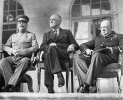-
Sign up or login, and you'll have full access to opportunities of forum.
You are using an out of date browser. It may not display this or other websites correctly.
You should upgrade or use an alternative browser.
You should upgrade or use an alternative browser.
Milestones
- Thread starter admihoek
- Start date

Loxuru
Graf von Kreuzigung
German offensive ability had already been crippled after the failure of Operation Barbarossa and the Battle of Moscow in December 1941. From then on, choises had to made where to strike. This resulted into Case Blue in 1942, when an economical objective was preferred over a political or military-strategical. Trying to gain time by slowing down the growth of Soviet war economy, by cutting off the oil supply from the oil fields near the Caspian Sea region to the factories in the Urals (or, preferrably, seize these oil fields) was at least a questionable choice, given the complexity of the operation. Then, there was a need to establish a defence line to cover the northern flank of the offensive, and this defence line hooked on the Wolga near a city, incidentally called Stalingrad. It was neither planned nor needed in Case Blue to take the city, but its namesake was too tempting for Hitler, so he drew more and more troops from the primary objective, in order to take part in the totally useless siege of Stalingrad, jeopardising the real objective of the offensive, which ultimately failed too.It pretty much ended German offensive ability in the East.
December 18th: A journey through history
1271: Founding of the Yuan Dynasty. ...
1642: European discovery of New Zealand. ...
1865: Abolition of slavery in the USA. ...
1892: Premiere of Tchaikovsky's "The Nutcracker" ...
1916: End of the Battle of Verdun. ...
1944: First edition of the French newspaper "Le Monde"
1271: Founding of the Yuan Dynasty. ...
1642: European discovery of New Zealand. ...
1865: Abolition of slavery in the USA. ...
1892: Premiere of Tchaikovsky's "The Nutcracker" ...
1916: End of the Battle of Verdun. ...
1944: First edition of the French newspaper "Le Monde"
- Some events on December 20th
- 69: In the Year of the Four Emperors, Aulus Vitellius is chased out of the imperial office in Rome by Marcus Antonius Primus
- 1256: A Mongol army under their Khan Hülegü takes the mountain fortress Alamut after several weeks of siege
- 1552: Katharina von Bora dies
- 1803: France hands over New Orleans to the USA as part of the Louisiana Purchase.
- 1860: South Carolina becomes the first state to secede from the USA and initiates the formation of the Confederate States of America.
1910: Atomic nucleus discovered
1917: Soviet Cheka founded
1956: GDR gift service "Genex" founded
1963: The first Frankfurt "Auschwitz Trial" begins
1972: Switzerland recognizes the GDR


